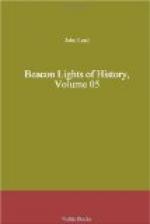The Middle Ages produced no more interesting man than Anselm, Abbot of Bec and Archbishop of Canterbury,—not merely a great prelate, but a great theologian, resplendent in the virtues of monastic life and in devotion to the interests of the Church. He was one of the first to create an intellectual movement in Europe, and to stimulate theological inquiries.
Anselm was born at Aosta, in Italy, 1033, and he died in 1109, at the age of 76. He was therefore the contemporary of Hildebrand, of Lanfranc, of Berenger, of Roscelin, of Henry IV. of Germany, of William the Conqueror, of the Countess Matilda, and of Urban II. He saw the first Crusade, the great quarrel about investitures and the establishment of the Normans in England. Aosta was on the confines of Lombardy and Burgundy, in a mountainous district, amid rich cornfields and fruitful vines and dark, waving chestnuts, in sight of lofty peaks with their everlasting snow. Anselm belonged to a noble but impoverished family; his father was violent and unthrifty, but his mother was religious and prudent. He was by nature a student, and early was destined to monastic life,—the only life favorable to the development of the intellect in a rude and turbulent age. I have already alluded to the general ignorance of the clergy in those times. There were no schools of any note at this period, and no convents where learning was cultivated beyond the rudiments of grammar and arithmetic and the writings of the Fathers. The monks could read and talk in Latin, of a barbarous sort,—which was the common language of the learned, so far as any in that age could be called learned.
The most famous place in Europe, at that time, where learning was cultivated, was the newly-founded abbey of Bec in Normandy, under the superintendence of the Archbishop of Rouen, of which Lanfranc of Pavia was the prior. It was the first abbey in Normandy to open the door of learning to the young and inquiring minds of Western Europe. It was a Benedictine abbey, as severe in its rules as that of Clairvaux. It would seem that the fame of this convent, and of Lanfranc its presiding genius (afterwards the great Archbishop of Canterbury), reached the ears of Anselm; so that on the death of his parents he wandered over the Alps, through Burgundy, to this famous school, where the best teaching of the day was to be had. Lanfranc cordially welcomed his fellow-countryman, then at the age of twenty-six, to his retreat; and on his removal three years afterwards to the more princely abbey of St. Stephen in Caen, Anselm succeeded him as prior. Fifteen years later he became abbot, and ruled the abbey for fifteen years, during which time Lanfranc—the mutual friend of William the Conqueror and the great Hildebrand—became Archbishop of Canterbury.




